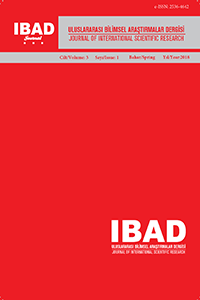Öz
Son yıllarda işletmeler dijital teknolojiyi çok
yoğun olarak kullanmaya başladılar.
Dijital teknoloji işletmelerin kendileri için ön gördükleri hedeflerine
ulaşması yönünde gittikçe önem kazanmaktadır. İşletmeler dijital
teknolojiden karar süreçlerinde, üretim
süreçlerinde, farklı ürün tasarımlarında, yüksek kaliteli servisler sunmada ve
zaman, maliyet risklerine karşı yararlanmaktadırlar. Bu durumun etkisi ile
dijital teknoloji tüm endüstrilerde yeni
radikal yapılanmalara neden olmuştur. Dijital teknolojinin yönetilmesi daha
önceki teknolojilere göre daha zor olmaya başladı. Dijital teknoloji ile
firmadaki tüm süreçler üzerinde köklü
değişim ve dönüşüme olmaktadır. Özellikle, inovasyon yönetimi sürecindeki yeni
bakış açıları ve sorunların çözüm yöntemleri üzerine çok geniş bir kullanım
fırsatı sunmaktadır Bu yeni bakış açıları ise özellikle, işletmelerin inovasyon
süreci, ürün ve hizmet portföyü ve kaynak çevreleri üzerinde değişimlere neden
olmaktadır. Bu makalede, işletmelerin dijital inovasyon stratejisini
desteklemek için bir yönetim çerçevesi sunulmaktadır. Dijital inovasyon
stratejisinde devam eden gelişmeleri desteklemek üzere hazırlanan çerçeve, üç
temel alanı kapsar: İşletmenin örgütsel yapıları, ürün geliştirme mantığı,
dijital çevre analizi. Son olarak da, akademik ve iş dünyası için öneriler
önermektedir
Anahtar Kelimeler
Dijital yenilik stratejisi dijital ürün geliştirme mantığı değer önerisi kullanıcı deneyimi
Kaynakça
- Arthur, W. B. (2009). The nature of technology: What it is and how it evolves. New York: The Free Press.
- Axelrod, R., & Cohen, M. D. (2000). Harnessing complexity: Organizational implications of a scientific frontier. New York: Free Press.
- Brynjolfsson, E., and McAfee, A. 2014. The Second Machine Age: Work, Progress, and Prosperity in a Time of Brilliant Technologies. New York, NY: WW Norton & Company.
- Burt, R. S. (1992). Structural holes: The social structure of competition. Cambridge, MA: Harvard University Press.
- Chesbrough, H., & Rosenbloom, R. S. (2002). The role of the business model in capturing value from innovation: Evidence from Xerox Corporation’s technology. Industrial and Corporate Change, 11(3), 529—555.
- Christensen, Clayton M. (2003). The innovator's solution : creating and sustaining successful growth. Harvard Business Press. ISBN 978-1-57851-852-4.
- Evans, D.S., Hagiu, A., and Schmalensee, R. 2006. Invisible Engines, How Software Platforms Drive Innovation and Transform Industries MIT Press, Cambridge, Massachusetts, London, England.
- Kulatilaka, N., & Venkatraman, N. (2001). Strategic options in the digital era. Business Strategy Review, 12(4), 7-15.
- Lee, J., & Berente, N. (2012). Digital innovation and the division of innovative labor: Digital controls in the automotive industry. Organization Science, 23(5), 1428—1447.
- Lucas, H. C., Jr., & Goh, J. M. (2009). Disruptive technology: How Kodak missed the digital photography revolution. The Journal of Strategic Information Systems, 18(1), 46—55.
- Markus, M.L., & Loebbecke, C. (2013). Commiditized digital processes and business community platforms: new opportunities and challenges for digital business strategies. MIS Quarterly, 37(2), 649-652.
- M. Hassenzahl, N. Tractinsky, User experience: A research agenda, Behav. Inform. Technol. 25 (2006) 91- 97
- Nyle´n, D., Holmstro¨m, J., & Lyytinen, K. (2014). Oscillating between four orders of design: The case of digital magazines. Design Issues, 30(3), 53—68.
- O’Reilly, C. A., III, & Tushman, M. (2008). Ambidexterity as a dynamic capability: Resolving the innovator’s dilemma. Research in Organizational Behavior, 28, 185—206.
- Ribeiro, N. (2011). Managing in the digital era, CreateSpace Independent Publishing Platform, Portugal
- Westergren, U. H., & Holmstro¨m, J. (2012). Exploring preconditions for open innovation: Value networks in industrial firms. Information and Organization, 22(4), 209—226.
- Yoo Youngjin , Henfridsson Ola, Lyytinen Kalle (2010): Research Commentary: The New Organizing Logic of Digital Innovation: An Agenda for Information Systems Research Information Systems Research 21(4), pp. 724–735,
- Yoo, Y., Lyytinen, K. J., Boland, R. J., Jr., & Berente, N. (2010, June 8). The next wave of digital innovation: Opportunities and challenges: A report on the research workshop ‘digital challenges in innovation research.’ Retrieved from http:// papers.ssrn.com/sol3/papers.cfm?abstract_id=1622170
- Yoo, Y., Boland, R. J., Jr., Lyytinen, K., & Majchrzak, A. (2012). Organizing for innovation in the digitized world. Organization Science, 23(5), 1398—1408
Ayrıntılar
| Bölüm | Makaleler |
|---|---|
| Yazarlar | |
| Yayımlanma Tarihi | 31 Ağustos 2018 |
| Yayımlandığı Sayı | Yıl 2018 Cilt: 3 Sayı: 1 |
Kaynak Göster
Cited By
DİJİTAL ÇAĞDA İNOVASYON YÖNETİM YETENEĞİ: BİR TEKSTİL BOYA APRE İŞLETMESİNDE DURUM ÇALIŞMASI
Erzincan Binali Yıldırım Üniversitesi İktisadi ve İdari Bilimler Fakültesi Dergisi
https://doi.org/10.46482/ebyuiibfdergi.1539138
DIGITALIZATION IN ACCOUNTING
Niğde Ömer Halisdemir Üniversitesi Sosyal Bilimler Enstitüsü Dergisi
https://doi.org/10.56574/nohusosbil.1478554
IBAD Sosyal Bilimler Dergisi / IBAD Journal of Social Sciences / IBAD
IBAD, EBSCO, SCOPUS, E-SCI ve TÜBİTAK/ULAKBİM(TR) SBVT tarafından DİZİNLENMEK ÜZERE değerlendirme sürecindedir.
Dergimizin sekreterya ve dizin/indeks takibi işlemleri dergieditoru.com tarafından yürütülmektedir.


